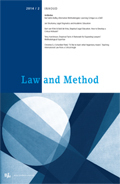|
Behandeld wordt de vraag of en hoe door educatie een bijdrage kan worden geleverd aan beroepsethisch handelen in het notariaat. Ik doe dat door de opleidingseisen te differentiëren al naar gelang de verschillende gedaanten die de notarieel jurist aanneemt: die van student, beginnend notarieel jurist en notarieel jurist met een afgeronde beroepsopleiding. |

| Artikel |
|
| Keywords | education, notaries, legal ethics |
| Authors | Boudewijn Waaijer |
| AbstractAuthor's information |
| Artikel |
|
| Keywords | legal research, legal education, epistemology, law, science and art |
| Authors | Wouter de Been |
| AbstractAuthor's information |
|
Classic pragmatists like John Dewey entertained an encompassing notion of science. This pragmatic belief in the continuities between a scientific, ethical and cultural understanding of the world went into decline in the middle of the 20th century. To many mid-century American and English philosophers it suggested a simplistic faith that philosophy and science could address substantive questions about values, ethics and aesthetics in a rigorous way. This critique of classic pragmatism has lost some of its force in the last few decades with the rise of neo-pragmatism, but it still has a hold over disciplines like economics and law. In this article I argue that this criticism of pragmatism is rooted in a narrow conception of what science entails and what philosophy should encompass. I primarily focus on one facet: John Dewey’s work on art and aesthetics. I explain why grappling with the world aesthetically, according to Dewey, is closely related to dealing with it scientifically, for instance, through the poetic and aesthetic development of metaphors and concepts to come to terms with reality. This makes his theory of art relevant, I argue, not only to studying and understanding law, but also to teaching law. |


